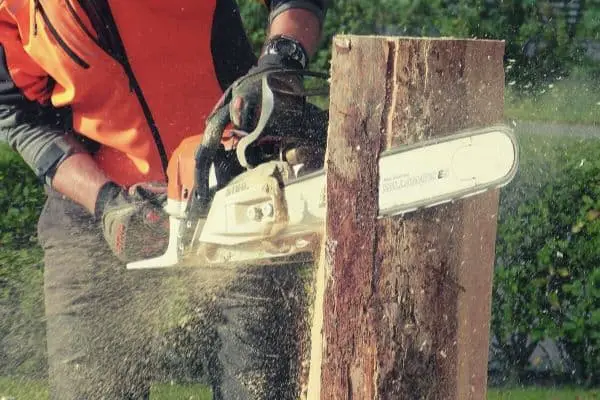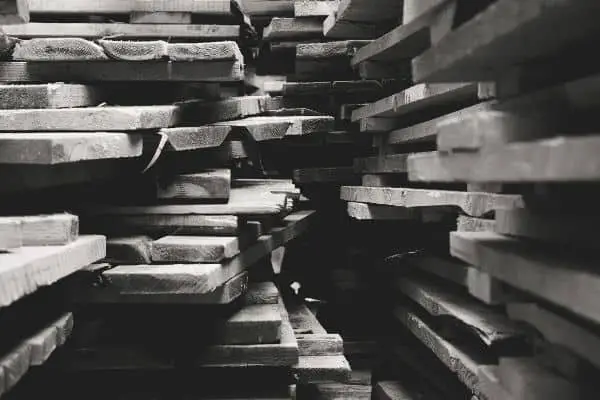If you’re out chopping down a tree or cutting up firewood, you have two choices of tools: an old-fashioned ax or a high-powered chainsaw. Their ability to chop wood is where their similarities end, though. In the age-old question of ax vs. chainsaw, you might be wondering which is better to use. That depends on what you’re trying to do.
There are quite a few reasons why you might choose an axe over a chainsaw such as chopping limbs or cutting at roots near the dirt. In terms of getting the job done quickly though, a chainsaw is better to use for crosscutting through trunks and larger branches. It can promptly slice through the largest tree trunks and makes quick work of large pieces of firewood.
Axes have been around for thousands of years, and the fact that they’re still a commonly used tool means they have their purposes. They’re great for exercise, arguably safer, much cheaper, and they need a lot less maintenance. Each tool is more suitable for different tasks and jobs. Keep reading to find out which tool you’ll want to use and under what circumstances.
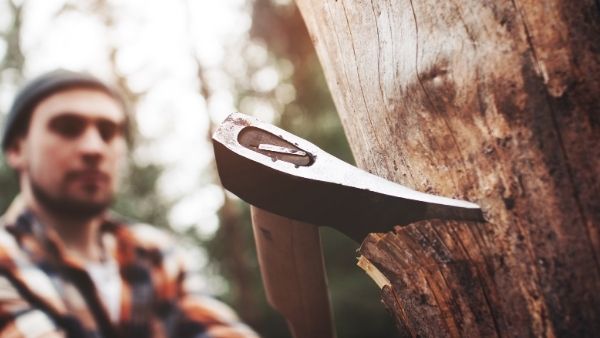
Ax vs. Chainsaw: Which One is Better?
While the chainsaw is faster and will yield cleaner cuts with less wasted wood, you probably want to take a few factors into account when choosing which tool you want to use. Of course, if you’re cutting a lot of wood, you’ll probably have both tools in your toolshed. Some of the criteria to consider include the following:
- Power Source
- Cutting speed
- Maintenance/upkeep requirements
- Price
- Safety
- Versatility
- Ease of Use
Of course, the most important thing to consider is the type of job you’re doing, since the two tools handle different kinds of jobs differently. Neither device is better; it all depends on what you’re trying to do with it.
Ax vs. Chainsaw: Pros and Cons
Below, you’ll find a table showing some comparisons between axes and chainsaws. We’ll delve more deeply into the criteria we mentioned above throughout the rest of the article and discuss some tasks that axes are better for and jobs where the chainsaw rules.
| Ax | Chainsaw | |
| Power Source | Manual | Motor |
| Speed | Slow | Fast |
| Maintenance Requirements | Low | High |
| Price | Low | High |
| Safety Danger | Moderate | High |
| Versatility | High | Moderate |
| Ease of Use | Moderate | Moderate |
Let’s spend some time looking at these criteria more closely, so you’re better able to choose the right tool for your next wood-chopping job.
Power Source
Many people prefer using an ax because it’s a manual tool, and you’ll get a great workout if you spend a couple of hours swinging one. It’s an excellent cardiovascular exercise, as well as a strength-based exercise for your back, arms, and chest. Men’s Journal suggests you can burn 400-500 calories an hour chopping or splitting wood. You may also find you prefer the ax because it doesn’t use gasoline as a chainsaw does.
This especially may make a difference if you’re worried about avoiding the use of fossil fuels. Although chainsaws don’t use a massive amount of gas, it’s still more fuel than none.
However, the fact that a chainsaw has a motor and uses fuel means that it has a lot more cutting power than a single swing of an ax, uses a lot less of your energy to use (although chainsaws are heavy and can be tiring as well). You might spend more money on fuel, and you’ll spend less time cutting.
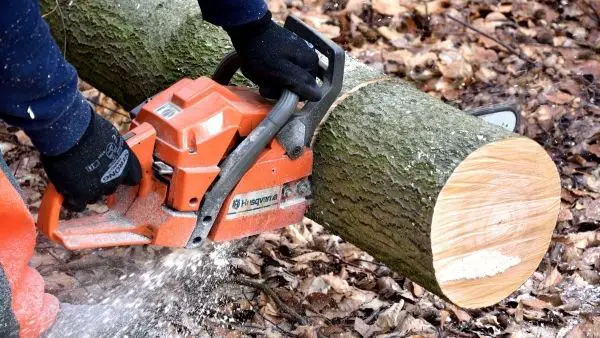
Speed
The chainsaw easily is preferable because of how fast it can cut through wood. Generally speaking, depending on the user, a chainsaw will cut through a tree much more quickly than an ax. Most chainsaws have an maximum operating RPM of between 10k and 14k. Your ax can only go as fast as you can, and you’ll find that it takes a lot longer to chop through a tree trunk.
Axes are much better suited to cutting down just one or a few smaller trees. It’s also better suited to clearing out smaller brush or splitting logs along the grain if you’re cutting firewood. Since axes are usually a lot lighter than a chainsaw, you might even go faster with an ax you’re only trying to chop off limbs of trees.
Maintenance Requirements
Like any tool with moving parts and a motor, a chainsaw will require a lot of extra maintenance that an ax simply won’t. For an ax, the most you’ll have to do is check the handle for cracks and sharpen the blade occasionally.
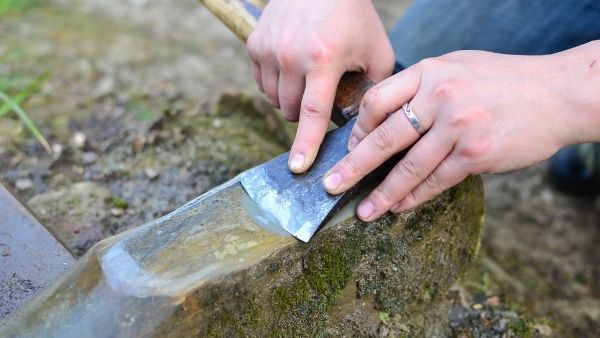
Chainsaws require, at a minimum, the following to keep them in tip-top working shape:
- Keep it well-oiled
- Sharpen the blades periodically
- Remove the chain and cleaning parts
- Use fresh gas of the correct mixture
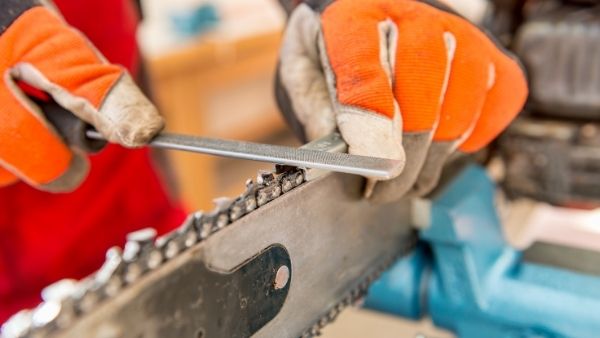
If you’re cutting a lot with your chainsaw, you’ll be performing more regular maintenance on it; as you use it, the blades will dull more often, it could start cutting to the side, it will be dirtier, and you’ll have to fill it with new gas. None of these tasks will take too much of your time, but if you’re not particularly diligent about taking care of your tools, it will add some more requirements to your life.
Axe vs. Chainsaw Price Comparison
A decent ax, such as this gorgeous Snow & Nealley found on Amazon.com, will probably cost you between $50 and $100, and unless you have to purchase a new handle, it’s not going to cost you much more over the life of the ax. This makes the ax an affordable tool that almost anyone can add to their tool shed.
Chainsaws, on the other hand, are much more expensive. The cheapest models will start around $150, and they’ll go up in price from there depending on their size and available features. A good quality saw like this Husqvarna from Amazon.com is well worth the little more money it costs. You’ll also shell out money for fuel, oil, and the tools you’ll need to keep it sharp and operating correctly.
Safety
Safety between the two is debatable, and it depends on how much experience you have with using them. Modern chainsaws often have a variety of safety features, including:
- Throttle-lock: prevents the accidental engagement of the throttle without having the lock depressed
- Easy stop control: allows you to brake the saw blade in an emergency
- Chain catch: catches broken or derailed chains
- Handguard: plastic shielding that guards your hand against broken chains
With all that, chainsaws are still dangerous. Nearly 30,000 people in the U.S. end up needing medical care each year due to injuries from chainsaws. If you’re not using it correctly, the chainsaw can kick back out of the piece of wood you’re cutting and hit you.
Axes are dangerous as well, and it’s relatively easy to miss what you’re trying to cut and end up with an ax blade lodged in you. However, there aren’t any statistics available for how many injuries are sustained from axes each year, which may mean they don’t result in nearly as many chainsaws.
The best way to stay safe using either an axe or a chainsaw is to be very familiar with the correct usage of each of these tools and to wear the correct PPE to protect yourself in case of an accident. Here’s a great resource for Chainsaw Safety Equipment on Amazon.com.
Versatility
Axes are more versatile than chainsaws. They’re great for taking along on camping or outdoor trips, and since they’re lighter and easier to use, you can use them for a wider variety of tasks. They’re also better for splitting logs. Chainsaws are really good for two things: chunking logs into smaller pieces or cutting down trees.
Ease of Use
These tools require some skill and care to use correctly, so neither is significantly easier to use than the other. Axes require some upper body strength as well as coordination, but chainsaws do as well. Overall, axes are more straightforward due to the lack of moving parts and the fact that they’re lighter, but there are tradeoffs for using either.
Closing Thoughts
Chainsaws are faster than axes, but each tool is better for specific tasks. Axes are arguably more versatile and give you a great upper-body workout. Chainsaws have higher maintenance, but there’s nothing better for cutting down a lot of large trees.




